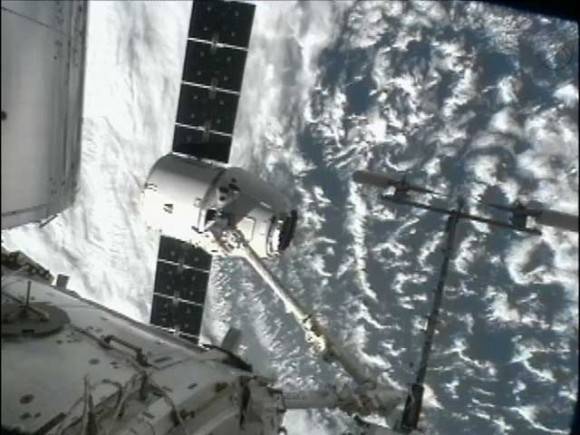 At 6:56 am EDT today a robotic arm on the International Space Station captured the Dragon vehicle. Aboard Dragon are Antares, the SSEP Mission 2 to ISS experiments payload, and Aquarius II, the Mission 1 experiments payload. With this milestone, the National Center for Earth and Space Science Education (NCESSE) and NanoRacks formally announce the start of SSEP on-orbit flight operations.
At 6:56 am EDT today a robotic arm on the International Space Station captured the Dragon vehicle. Aboard Dragon are Antares, the SSEP Mission 2 to ISS experiments payload, and Aquarius II, the Mission 1 experiments payload. With this milestone, the National Center for Earth and Space Science Education (NCESSE) and NanoRacks formally announce the start of SSEP on-orbit flight operations.
All student flight teams should prepare to conduct their ground control experiments based on actual Crew Interaction dates and times reported via the now operational “SSEP Mission 2 to ISS: Experiment Log”. Stacy Hamel, NCESSE’s Flight Operations Manager for SSEP, will be updating the Log as Crew Interaction information is piped from ISS to NASA to NanoRacks to NCESSE. All questions about the Log should be directed to Stacy: stacyhamel@ncesse.org
On October 9, 2012, all SSEP Mission 1 and Mission 2 Community Program Directors, Co-Directors, and Teacher Facilitators were sent a separate communication on ground control experiments and Log use. All Mission 2 flight experiment teams, as well as Mission 1 re-flight experiment teams, are to use this Log.
All flight experiment teams have defined, and NCESSE and NanoRacks have approved, Crew Interactions for, e.g., experiment activation and experiment de-activation, relative to specific days aboard ISS, which are designated (Arrival + XX days) and/or (Undocking – YY days). A number of activations are scheduled on the day of arrival (A =0), which is the day Antares and Aquarius II are unloaded from Dragon and brought through the hatch onto ISS.
Anyone interested in following along on the flight of Antares and Aquarius II are invited to visit (throughout the flight) the SSEP Mission 2 to ISS: Experiment Log (see the link below). NCESSE and the Arthur C. Clarke Institute for Space Education, NCESSE’s international arm, would like to especially invite 7,000 students across the U.S. and Canada to follow along – the students currently engaged in experiment design for SSEP Mission 3 to ISS. Mission 3 flight experiment selection will take place in December 2012, and a flight to ISS is expected in Spring 2013. Mission 3 student researchers – here is a wonderful opportunity to get into the spirit of exploration with Missions 1 and 2 now underway on ISS.
A NOTE TO MISSION 1, 2, AND 3 COMMUNITY PROGRAM DIRECTORS, CO-DIRECTORS, AND TEACHER FACILITATORS: encourage your students, through their parents, to subscribe to this SSEP National Blog for email notification of breaking news on flight operations and program activity. You can subscribe at the bottom of the right column on the home page: http://ssep/ncesse.org
Jump to: SSEP Mission 2 to ISS: Experiment Log
ps–
Something cool … want a sense of how far we have come technologically? I wrote this post and published it on the internet while sitting on American Airlines flight 1705, cruising 5 miles above the Earth (that’s 18 Empire State Buildings one on top of the other) en route to the great State of Texas.
pps-
I Googled the height of the Empire State Building while on a plane 18 Empire State buildings into the sky.
ppps-
ISS, a stunning technological achievement, is currently 51 times higher up than me – that’s 918 Empire State buildings up. (And, yes I Googled the current altitude of ISS from my plane too.)
-Jeff
SSEP is undertaken by the National Center for Earth and Space Science Education (NCESSE) in partnership with NanoRacks LLC. This on-orbit research opportunity is enabled through NanoRacks LLC, which is working in partnership with NASA under a Space Act Agreement as part of the utilization of the International Space Station as a National Laboratory.
SSEP is the first pre-college STEM (Science, Technology, Engineering, and Math) education program that is both a U.S. national initiative and implemented as an on-orbit commercial space venture.

Comments are closed.